The attack of Cambrai by the British was not success because the heavy tanks were unable to keep up the advance. Therefore, in 1917 the Ministry of Munitions gave the go ahead to create a new tank, the Medium A, to exploit the shortcomings of the heavy tanks.
The Medium A tank had a low track profile and a built-up superstructure. It had two power-plants, one for each track, that were 45 hp Tylor haulage truck engines. Having two engines made the tank very difficult to master, mainly because gearsmen had to manhandle two separate gear boxes, trying not to stall one engine while changing gears on the other. The Medium A had four guns, but the cramped conditions inside meant you could only fit three people in to operate them. Still, at 8 mph (13 kmh), the tank was fast by WWI standards and therefore was nicknamed the ‘Whippet’ after the skinny racing dog similar to a small greyhound.
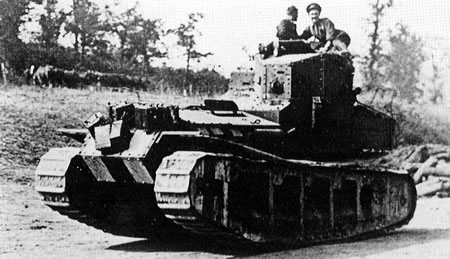 Unfortunately the Whippet came into action just as the Germans began their great spring offensive of 1918, so the tank never had the opportunity to be used in its intended role. However, this little gem performed admirably during its first outing at the Somme in March 1918, where twelve Whippets halted and routed a German advance made up of three hundred German infantry. After a brief skirmish at Villers Bretonneux, the full potential of the Whippet was realized in August 1918.
Unfortunately the Whippet came into action just as the Germans began their great spring offensive of 1918, so the tank never had the opportunity to be used in its intended role. However, this little gem performed admirably during its first outing at the Somme in March 1918, where twelve Whippets halted and routed a German advance made up of three hundred German infantry. After a brief skirmish at Villers Bretonneux, the full potential of the Whippet was realized in August 1918.
Even though the Medium A was the Tank Corps’ new innovation, it was the Mark V tank that really shook things up. The Mark V tank had an epycyclic gearbox, allowing it to be driven by one person, and a purpose built 150 hp Ricardo engine. The Mark V was much more effective in action due to its smooth gear changes, better steering and increased power. The Mark V also had better armor, 14 mm (9/16 inch), than all previous British tanks. Because of the new gear system, it meant that they could free up the gearsmen amongst the 8-man crew for other tasks, so all the machineguns were manned, including an extra one in the back over the fuel tank. On the outside the look of the tank was almost the same as the Mark IV. Vision was improved via a raised cab in the top of the hull at the rear, which also allowed the crew to deploy the unditching beam without leaving the tank. The Mark V also had a fan behind the sponsons and louvres for ventilation. Four hundred Mark V tanks were built, as well as three hundred modified versions known as Mark V Star or Mark V*, which was a longer version (by 6 feet, 1.82 meters) of the Mark V that could cross 13 foot (3.96 meters) trenches without the use of fascines.
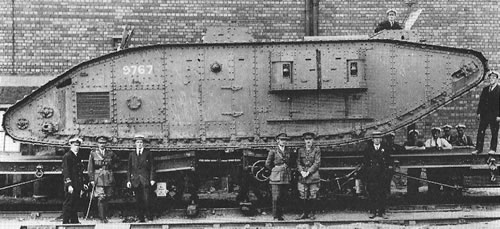 The Mark V* tanks could be used as troop carriers, with the large interior able to accommodate twenty-five men, but the fumes and poor air often made the men feel sick and too ill to fight when they disembarked so the tank was rarely used in this capacity.
The Mark V* tanks could be used as troop carriers, with the large interior able to accommodate twenty-five men, but the fumes and poor air often made the men feel sick and too ill to fight when they disembarked so the tank was rarely used in this capacity.
The Mark V* was used right through to the end of the war. However, it was observed that it was not an ideal machine for maneuverability due to its length, so a Mark V** was built. The Mark V** tank was the same length as the Mark *, but the tracks were not in contact with the ground as much and the front rose more sharply to improve climbing. Also the guns had a more sophisticated range detecting method and the use of voice-pips was implemented to aid internal comms. However, built in November 1918, the Mark V** tanks were too late to see any action in the war that ended soon afterwards.
The Mark V* was the last British tank to see action in World War I, though work continued on new designs throughout 1918. A wooden model of a Mark VI was made, but the actual machine was never produced, though three Mark VII tanks were completed. The Tank Corp had a great offensive planned for early 1919, expecting to use their new Mark VII tank, which was based on earlier designs and built with the help of American manufacturing.
The Americans became involved with the Mark VII Tank soon after they became involved in the war on April 6 1917, after several trials with experimental machines.
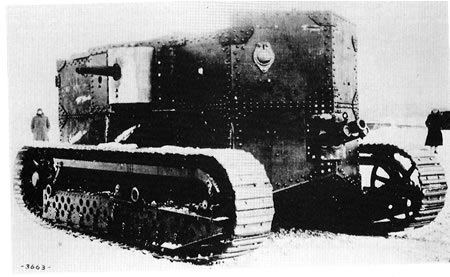 The first American tank was constructed by the Holt Tractor Company, whose tractors were instrumental in the development of other countries’ first tanks. The American’s ‘Gas-Electric’ was similar to other early tanks based on their Holt tracks, with an armored body like a box and a 74 mm howitzer in the nose. The gasoline-electric transmission made steering simpler, but only one of these early tanks was ever built. Following the British, this original style of tank was abandoned, in favor of a tank with all-round tracks, though a steam tank and skeleton tank were among the many prototypes built in America.
The first American tank was constructed by the Holt Tractor Company, whose tractors were instrumental in the development of other countries’ first tanks. The American’s ‘Gas-Electric’ was similar to other early tanks based on their Holt tracks, with an armored body like a box and a 74 mm howitzer in the nose. The gasoline-electric transmission made steering simpler, but only one of these early tanks was ever built. Following the British, this original style of tank was abandoned, in favor of a tank with all-round tracks, though a steam tank and skeleton tank were among the many prototypes built in America.
A lot of America’s early prototype tanks utilized great inventiveness, but proved to be useless as weapons of war on the battlefield. It became obvious to the United States Ordnance Department that there was little time for experimentation, so they redirected their efforts into using tank designs already in use by the British and French and manufacturing British Mark VIII’s and the and the Six-Ton Tank, as well as developing a smaller version of the French FT 17, calling it the ‘Two-Man Tank’. The Two-Man Tank used two Model T Ford engines and various other American car components – only fifteen of these were built however, despite 15,015 being ordered.
The Mark VIII tank was the most advanced heavy tank of World War I, being larger and more powerful than all the others before it. Despite weighing 37 tons, the American 300 hp Liberty engine allowed it to travel up to 6 mph (kmh). The Anglo-American Commission originally planned to build 1500 Mark VII Tanks at their new factory in France, with British bodies and tracks and American guns and gears. As well as the joint venture, it was agreed that Britain and America would build their own versions of the Mark VII with small modifications. The British tanks had two Ricardo engines sending power to one crankcase and producing 300 hp. Because they needed the six-pounder guns to attack the newly arrived German tanks, all the Mark VIII Tanks were male.
The Mark VIII tanks were being built for a big push against Germany in 1919, but the war ended and the Armistice was agreed upon by the end of 1918 so only five were ever fully completed.
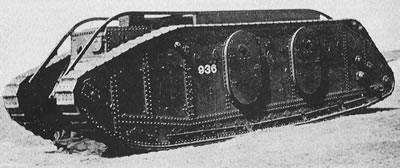 The Mark IX, a medium tank and specialist supply carrier, would also have been produced if the war had continued. This tank was the last of the ‘Mother’ type tanks, though it wasn’t really meant for fighting – it was only armed with two Hotchkiss machineguns and was primarily designed to carry troops or supplies. Only one of these vehicles was produced in time to see action before the end of the war, and it was used as an ambulance in France. In Britain experimental work was carried out on the Mark IX at a Hendon reservoir, using floatation tanks to make the vehicle amphibious.
The Mark IX, a medium tank and specialist supply carrier, would also have been produced if the war had continued. This tank was the last of the ‘Mother’ type tanks, though it wasn’t really meant for fighting – it was only armed with two Hotchkiss machineguns and was primarily designed to carry troops or supplies. Only one of these vehicles was produced in time to see action before the end of the war, and it was used as an ambulance in France. In Britain experimental work was carried out on the Mark IX at a Hendon reservoir, using floatation tanks to make the vehicle amphibious.
A new type of Whippet was also built, the Medium B, to support the Mark VIII’s and Mark IX’s. Forty-five of the Medium B tanks were built, shaped more like a heavy tank, armed with machineguns and containing a crew compartment and a 100 hp Ricardo engine. The Medium B was considered poor, with cramped conditions inside making it difficult to maintain, and its successor, the Medium C ‘Hornet’, was far superior with its 150 hp Ricardo engine and crew-suggested implementations – such as voice-pips for comms and a rotating cupola for the commander. Forty-eight of these tanks were built, all female, but none of them saw any action.
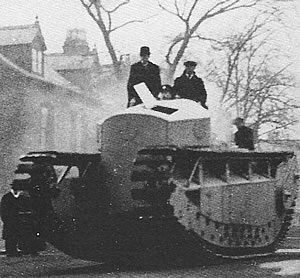 A fourth tank in the range, the Medium D, was considerably different in design to its three predecessors. It weighed only 20 tons and, because of its powerful 240 hp engine and flexible tracks allowing a smooth ride, was capable of reaching 20 mph (32 kmh), lightening fast compared to any other tanks before it.
A fourth tank in the range, the Medium D, was considerably different in design to its three predecessors. It weighed only 20 tons and, because of its powerful 240 hp engine and flexible tracks allowing a smooth ride, was capable of reaching 20 mph (32 kmh), lightening fast compared to any other tanks before it.
These Mediums were ready and waiting for the big armored push of 1919, which never took place because the German army was quashed after the tank attack that began at the battle of Amiens. In the end none of these Mediums were ever used in battle. More than four hundred tanks were placed near Amiens for a massive attack on August 8 1919, which smashed through enemy lines and Medium A’s and Austin armored cars rushed ahead of the heavy tanks and sent the Germans fleeing in panic. A succession of similar battles followed, with the Germans retreating and morale wavering, until the German army was defeated after three months of intense fighting. The Tank Corp was stretched to the limits and only 8 Whippets remained for the final battle of World War I, at Mormal on November 5 1918. However, the tank played a pivotal role in the allied victory over Germany, a fact acknowledged by the German Supreme Commander, General Ludendorff, when he called the time of the initial tank assault on August 8th ‘the black day’.
Nevertheless, victory did not come cheap – more allied lives were lost during the final year of WWI than were lost in the rest of the war combined.
After The War
It is without doubt that the British made the best tanks of World War I, and over 2800 were built by the end of the war. The ‘Mother’ tanks were the best design for the job, and demonstrated that trench warfare was practically obsolete. Their success in ending this style of fighting meant that, apart from a brief outing for a small detachment during the Russian Civil War, these types of tanks were no longer needed and, in fact, they were never used again. With the war over, designers had more time and freedom to experiment with tanks so that in the 1920’s British tanks had low tracks and guns in rotating turrets as used in the French Renault AT 17. Somewhat bizarrely, the French decided to adopt the all-round tracks after the failure of their St Chamonds and Schneiders, which they kept going with right up to World War II, when it became obvious their ideas were ill-conceived due to extremely poor fighting performance against contemporary tanks.
The German tanks of World War I were abysmal, hastily put together and altogether ineffective. However, the Germans took the most away from World War I in terms of what they learned from their defeat. They made tanks and tank warfare into something resembling an art-form as they rearmed during the 1930’s, so that it was the allies who were desperately playing catch-up with their tank designs during the first years of World War II. For a time the German Panzers were practically unstoppable.